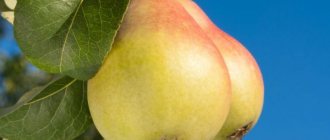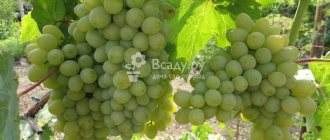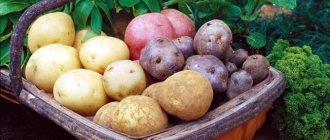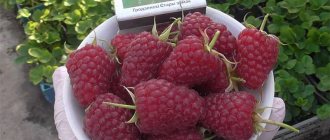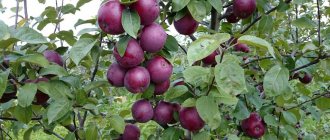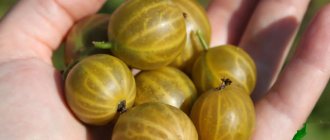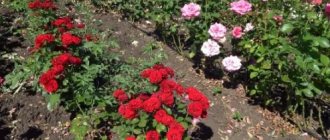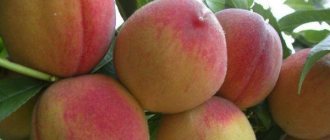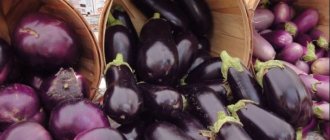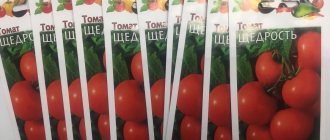Classification of peach varieties by ripening time
This culture is not considered durable. All trees grow quickly and die at the same speed. In fact, several types of fruits are called peaches: nectarines, Potanin almonds and figs. There is a fourth type with pubescent fruit. They are called real peaches. All varieties differ from each other in frost resistance, fruit shape, and pulp taste. In each of the 4 groups, species differ in terms of maturation. When planting, you need to know such features in order to properly care for the tree.
Early peach varieties
Some species of this plant allow you to enjoy sweet fruits in the summer. For example, the Kiev early variety produces the first peaches within 3 years after planting. The tree blooms in May and produces future fruit until mid-July. In the second ten days of the month you can collect sweet fruits. This species is classified as high-yielding. From one plant you can collect up to 50 kg of fruit.
The first fruits on Greensboro trees appear within 2 years after planting. This type of peach is highly valued for its delicate and sweet taste, which is rated 4.8 out of 5. From a tree that has reached the age of 10 years, you can harvest up to 67 kg of harvest. Greensboro fruits are not suitable for transportation due to their tendency to darken with any deformation of the skin, so they can only be enjoyed in cold regions by growing the variety in a greenhouse.
Another popular type of early-ripening peaches is Redhaven. This variety is suitable for growing in central Russia, but only those seedlings that were purchased from local nurseries are suitable. Such trees are adapted to colder climates, which is why they tolerate winter better. Harvesting takes place from the 30th to the 40th day, starting from the 2nd decade of July. After 10 years of life, the tree can produce up to 110 kg of fruit. The best early peach varieties include:
- Morettini;
- May flower;
- Juicy;
- Fluffy early.
Attention!
The pollination period and fertilizer schedule depend on the timing of ripening. In order to systematically harvest a large harvest and have sweet fruits, you need to choose varieties with a low crown. Spreading branches are easier to form and care for. For cultivation in Russia, experienced gardeners choose low trees: they are convenient to harvest from. Early ripening peach species have tasty and aromatic fruits. Such trees grow no more than 5 meters in height. The first flowers may appear as early as April.
Varieties of medium-ripening peaches
All trees of this type produce a large harvest. They are valued for their resistance to frost. All varieties of medium-ripening peaches are suitable for planting in central Russia. These species grow more than 5 meters in height and have a spreading crown. These varieties are chosen for export because... they can easily be transported. The fruits do not darken due to damage, so they reach store shelves fresh.
The large-fruited Collins peach is one of the shortest mid-ripening varieties. Such trees reach only 3-3.5 m in height. Growth noticeably slows down after the start of fruiting. Already in August, sweet, round-shaped peaches with velvety skin appear on the branches. Their weight can reach 155 g. The color of the fruit is bright orange with a crimson blush. The tree easily survives winter if the temperature does not drop below -23°C.
Medium-season peach varieties include White Swan. When such a tree reaches the age of 6 years, up to 60 kg of fruit can be collected from it per season. You can pick sweet fruits in the 1st or 2nd decade of August. The flowers do not require pollination, so they easily survive in areas with a shortage of bees. Many people value this variety for its resistance to frost. The white swan survives at temperatures down to -30°C.
If a gardener wants to grow a beautiful tree on his plot that will produce large fruits, the Cardinal variety is suitable for him. Peaches on such a plant first appear 2-3 years after planting. This variety is valued for its high and stable yield. The cardinal does not like a lack or excess of moisture. The amount of harvest is affected by the frequency and appropriateness of fertilizing. You can collect fruits from mid-August until the second ten days of September.
Attention!
The Cardinal peach is afraid of frost, so in central Russia it can only be grown in greenhouses.
The artificially bred variety Golden Moscow appeared due to the crossing of the Elberta and Salvay species. Such a tree bears its first fruits starting from August 15th. Large peaches reach a weight of 185 g, and sometimes 200 g. Blush can occupy up to 75% of the skin. The pulp is juicy and aromatic, with a hint of sugar. Over the course of a year, Golden Moscow produces a harvest of up to 55 kg. Due to their high taste value and high vitamin content, the fruits are consumed fresh and are popular for making desserts.
The fruits of the columnar Balconella are valued for their bright taste. The pulp is juicy and smells pleasant. This low-growing variety has good frost resistance, but is not suitable for growing in northern regions. The tree reaches a height of only 1.5 m. The crown is neat and spherical. The first fruits appear on the branches in early or mid-August. The weight of one peach does not exceed 145 g.
The Augustine variety is popular because of the large fruits that first appear on the tree 2-3 years after the peach seedling is moved into open ground. They Fruits can weigh up to 200 g. The skin has slight pubescence and is marbled in color. The pulp is dense, with a sweet and sour taste. It separates from the pit relatively easily. This type of peach is easy to transport. During transportation, the fruits do not darken even from severe damage. Medium-late ripening varieties include:
- Saturn;
- Donskoy;
- Siberian;
- Kremlevsky.
Late peaches
From the moment of planting, the tree begins to bear fruit only after 5 years. These varieties are not suitable for cold climates. In central Russia, late peaches do not have time to ripen, so the pulp becomes sour. Because of this, these varieties are not grown in regions above the Rostov region. The first fruits appear on them only in mid-September. The harvest takes place until the beginning of October. The Crimea and the adjacent region are most suitable for growing such peaches.
Peach Jaminat is distinguished by oval fruits weighing up to 160 g. Their yellow flesh is sweet with sour notes. The skin is bright red, without spots. This variety begins to bear fruit in the first ten days of September. Jaminat is valued for its resistance to diseases and pests. Because of these characteristics, late-ripening peaches are often used for industrial cultivation.
The Frost variety came to Russia from America. Its fruits are large: they can reach a weight of 200 g. This peach is one of the most frost-resistant among late-ripening species. It can withstand temperatures down to -32°. The first fruits appear on the branches in September. Due to its fibrous structure, it is often used for making jams rather than fresh consumption. Frost is valued for its high yield.
The Elberta peach appeared thanks to American selection. Fruits weighing up to 150 g have ruddy skin with a rich yellow background. The oval fruit with an elongated nose is sweet, but has a slight sourness. This plant is considered the earliest of all late-ripening varieties. The harvest on the tree appears at the end of August (25-28th). Gardeners value Elberta for its resistance to weather changes and rapid growth.
Attention!
Late-maturing peach trees grow large and are therefore not suitable for small areas.
What is the peculiarity of winter-hardy varieties?
Varieties of winter-hardy peaches are able to withstand significant cold snaps. Even in middle and northern latitudes they can easily endure wintering, but there are a number of important nuances that not all gardeners know about.
Criterion for winter hardiness of the tree itself and individual flower buds
- Each species has a certain criterion for the winter hardiness of the tree itself and individual flower buds. The frost resistance index of a crop can reach up to -40 degrees, but flower buds, as a rule, can withstand -22 below zero, if we talk about winter-hardy varieties. So, strong, late cold snaps in northern latitudes can still deprive a gardener of a harvest.
- Winter-hardy varieties need to be properly cared for. If the tree is heavily overloaded with fruits, then winter hardiness will greatly decrease by the coming winter. This indicator also reduces the age of the tree. The older it is, the less cold it can withstand.
Frost-resistant varieties
Almost all varieties of peaches have always been positioned exclusively as southern plants. However, many varieties are also suitable for growing in mid-latitude or colder regions. Most of them are bred through selective breeding. Frost-resistant peaches can withstand temperatures down to -40°C. Such figures are relevant only for winter. After buds appear on the branches, the maximum permissible frost becomes -22°C, so late cold snaps can be fatal for the plant.
Winter-hardy varieties require more care. They need to be harvested on time. The lifespan of a tree is affected by the amount of fertilizing and the frequency of pruning. Frost resistance decreases if the gardener does not harvest on time. Overloading with fruits when the outside temperature drops sharply can destroy the plant. Also, resistance to cold decreases in peaches with age.
Babylonian
This variety was artificially bred from the Valiant and Miryanin species. It is often grown in the North Caucasus region. The trees are medium-sized with a spherical crown. This peach is valued by breeders for its large fruits weighing about 150 g. The pulp is sweet and sour, fibrous. It is difficult to separate the bone. Due to its bright taste, the fruit is often used for desserts. The Babylonian variety is classified as mid-season. The yield of this peach is high. Trees are not susceptible to powdery mildew.
Large-fruited peach varieties
Gardeners dream of planting a tree with large fruits. But to successfully obtain regular harvests, it is recommended to take into account additional characteristics:
- resistance to diseases and pests;
- precociousness;
- self-fertility;
- frost resistance;
- plant habit.
It may not be possible to select a tree with all the parameters for a given region. Then it is recommended to prefer a plant with average fruits, but giving stable yields in a given climate.
Self-pollinating self-fertile varieties
Such plants produce crops even when there is a shortage of bees. They need to be planted away from trees that are pollinated by insects. Experienced gardeners recommend placing several peaches of this type nearby. Cross pollination increases yield. However, these varieties also bear fruit well alone. They differ in frost resistance and fruiting time.
Self-pollinating species include:
- Volcano. Gives a big harvest. Resistant to many diseases, including fungal diseases. Easily tolerates sudden changes in temperature. The first fruits ripen in August. The skin is covered with a red blush, through which a yellow background is visible. The pulp is dense.
- Harnas. Differs in regularity of harvest. Resistant to prolonged frosts. The fruits are often used for making desserts and are rarely consumed raw. The variety is suitable for growing in cold regions, including Siberia. The fruits hold tightly to the stalks and do not fall off even after ripening.
- Golden Jubilee. This type of peaches is often grown for sale. The sweet fruits are covered with yellow skin with a red blush, which makes the fruit even more appetizing. One tree yields up to 50 kg of peaches.
Attention!
Bees can damage self-pollinating varieties, so such plants should be planted away from trees and flowers that need insects to bear fruit.
Adaptation of peach culture to growing conditions in the south of Russia
Peach is one of the most promising crops in southern gardening, but due to the possibility of freezing in the winter-spring period, the production of its fruits is unsustainable. Therefore, the huge ecological potential of the south of Russia and the natural potential of the peach crop and variety are often not realized. The article carried out environmental modeling of sustainable production of peach fruits in the North Caucasus using geographic information technologies, and examined the degree of its adaptation to growing conditions.
Peach is the most valuable crop of the south of Russia. Due to its high nutritional, medicinal, and decorative properties, it deserves wide distribution in cultivation in areas with favorable soil and climatic conditions that contribute to its normal growth and fruiting.
One of the most important conditions for the intensification of horticulture is the fullest use of environmental resources, which, first of all, provides for the correct territorial placement of fruit crops, including peaches.
The main climate factors limiting its cultivation in southern Russia are low temperatures in winter, late spring frosts, and sharp temperature fluctuations in winter.
Therefore, it is advisable to study the requirements of peach culture to the climatic conditions of the winter-spring period.
Even now, sometimes the characteristics of a crop or variety are more often determined by such vague concepts as frost resistance, winter hardiness, drought resistance, etc.
To predict the compliance of crop requirements and environmental conditions, critical and optimal temperature indicators for the onset of various phases of peach development have been established in quantitative values (Tables 1, 2) and a “corridor” of optimal and critical temperatures for its winter-spring development has been developed (Fig. 1) [1 ].
Table 1. Critical minimum temperature (°C) for peach by development phase, southern Russia
| Phases of development | Minimum temperature, °C |
| Forced rest | -25 |
| Swelling of flower buds | -23 |
| Blooming of flower buds | -15 |
| Appearance of petals | -8 |
| Bloom | -4 |
| Ovary | -2 |
Table 2. Optimal temperature indicators (°C) for the onset of developmental phases in peach, southern Russia
| Phases of development | Average daily temperature of the onset of the phase, °C |
| Swelling of flower buds | 4,5-6 |
| The beginning of active vegetation, the opening of flower buds | 9 |
| Bloom | 11 |
| Maturation | 20-23 |
Wood can withstand temperatures down to -27 °C in winter, and sometimes -30 °C (in places protected from winds). The critical temperature for peach flower buds in January-February is -23 °C. The area where it occurs in 40% of winters or more is unsuitable for peach.
The spring growing season of peach in the North Caucasus begins in late February - early March with average daily temperatures of about +4.5...+6 °C. When the sum of effective temperatures (above +5 °C) accumulates to more than 50 °C, the bud burst phase begins at average daily temperatures of +7.4 ... +9.8 °C. With the accumulation of the sum of effective temperatures of 70-100 °C at average daily temperatures of +9.2 ... +12.0 °C, flowering begins. This usually occurs in the second half of April. Depending on the weather conditions of the year, this phase shifts by 7-15 days.
Blooming flowers tolerate temperatures down to -4 °C. With abundant planting, trees can even maintain an average yield.
The process of fruit formation, depending on the variety, height and zone where the plantings are located, lasts 80-130 days. The ripening period for peach, depending on the variety, lasts 2.5-3 months, starting from the first ten days of July at average daily temperatures of +20.1...+24.5 °C. The sum of active temperatures (above +10 °C) required for the ripening of peach fruits, which begins to accumulate already during flowering, is 1000-1190 °C for early varieties, 1500-1700 °C for middle varieties and 2000 °C for late varieties.
A change in leaf color occurs at the end of October in the steppe and at the beginning of November in the foothill zones at average daily temperatures of +10...+10.5 °C. Leaf fall begins in the first ten days of November at average daily temperatures of +7 ... +9 °C. These periods may change and pass more intensely after autumn frosts and sub-zero temperatures for two to three days.
The best varieties of peaches for different regions of Russia
It is impossible to name one universal type of this fruit that would grow equally well in any part of the country. In different regions of Russia, climatic conditions can be hot, dry, humid, or characterized by long winters. In order for the tree to bear fruit well and the harvest to be sweet, you need to choose a variety based on the weather that prevails in the area where the garden is located.
Peach varieties for the middle zone
The climate of the regions located in this part of Russia does not spare southern plants. Only frost-resistant peach varieties are chosen for the middle zone. Other types of this fruit will quickly die. Plants that need bright sun all summer are also not suitable. During the ripening period, the fruits do not have time to gain enough heat, which is why the pulp turns out sour and tasteless. Many of them die with the first frost, because... the temperature begins to drop rapidly. Only winter-hardy varieties are suitable for growing in the middle zone:
- Kyiv early;
- Cardinal;
- Collins;
- Kremlevsky;
- Redhaven;
- Lebedev;
- Golden Moscow;
- Flamingo.
Peaches varieties for the south of Russia
For such a climate, choosing fruits is not difficult. In the Volgograd, Astrakhan regions and other regions located in the south, most types of peaches grow well. The only requirement for all varieties is abundant watering, because... Due to the heat, the soil dries out quickly. However, no type of fruit tolerates too much water. Otherwise the trees are unpretentious. Can easily cope with direct sunlight. The fruits are sweet and rich in vitamins. The following varieties are suitable for cultivation in the south of Russia:
- New;
- Steppe turnip;
- Fig white;
- Saturn;
- Vladimir.
Attention!
Fruits must be picked as they ripen, otherwise they will begin to rot due to the heat.
Rainbow peach is self-pollinating. It does not tolerate frost well, so it is grown only in warm regions. The fruits of this variety are large: up to 200 g. The yellow skin is covered with bright crimson spots. The iridescent appearance of peaches is prized for their tender flesh that melts in your mouth. The bone comes off easily. The first fruits appear on the tree in mid-July.
Steinberg is a dwarf variety of peaches. The trees grow only up to 2 m in height. With a relatively small size, they produce large fruits weighing up to 205 g. The peach can bear fruit for 15 years in a row. The fruit is valued for its tender and juicy pulp with a distinct taste. This species is completely immune to fungal diseases and is not afraid of overwatering or heavy rainfall.
Peach varieties for Kuban
To choose a plant that will delight you with its fruits every year, you need to pay attention to the soil. In the Krasnodar Territory, the soil varies, which is why not every variety gets along. The climate of Kuban is quite balanced, so many types of peaches can be grown in this region. In winter, the cold does not drop below -25°, so trees do not require increased frost resistance. Summer is warm enough for even late varieties to ripen.
Saturn peaches are often grown in Krasnodar. The fruits are small: weighing up to 100 g. Many breeders value this variety for the very sweet taste of the pulp. Unlike other species, Saturn does not have a sour taste. Fruits can be transported over long distances: they do not spoil too quickly and do not darken from deformation. The stone is easily separated from the pulp. The top of the fruit is covered with a delicate yellow skin with red barrels.
Another variety popular for growing in the territory of the former Kuban is Semirenko. These peaches are suitable for trade due to their sweet flesh and pleasant aroma. The first fruits from the trees can be collected in early July. The fruits are small: on average they weigh 120 g. The variety is resistant to diseases, so even a gardener without experience in growing southern fruits can cope with the care. The fruits are round in shape and have a fluffy, carmine-colored skin. The dark pulp has a pleasant smell and is difficult to separate from the stone.
Veteran is a large peach variety for Kuban, the fruits of which reach a weight of 160 g. The tree grows up to 5 meters. The crown is large and dense. The pulp is sweet, dense, with a slight sour aftertaste. In one season, Veteran produces up to 50 kg of harvest. Most of the fruits on the tree ripen at the end of August. Fruits do not spoil for a long time, so they are suitable for transportation. Also, the flesh does not darken from blows and cuts. This variety of peaches is not difficult to grow because... They are resistant to most diseases and pests. The veteran is not susceptible to powdery mildew and clasterosporiasis.
Not less often, the Autumn Blush peach is grown on the territory of the former Kuban. This variety produces gigantic fruits: up to 200 g. The pulp is not too juicy, with a bright sweet and sour taste. Cover the outside of the fruit with cream-colored skin. Thanks to their tender pulp, the fruits are equally often eaten raw and made into juices, preserves or jams. Autumn blush easily tolerates transportation, so it is often grown for sale. The best varieties of peaches for the Krasnodar region:
- Golden Jubilee;
- Early Kuban;
- Springold;
- Morettini's favorite;
- Redhaven;
- Collins.
Attention!
To grow in these weather conditions, you need peaches that are moderately resistant to cold.
The Boxer variety is popular in Kuban. It does not require special care and is not picky about the soil. The harvest will be equally rich for trees growing in clay soils and on sand. The fruits of this variety are completely pubescent. The plant is winter-hardy and easily copes with temperatures up to 30°. The weight of one fruit can reach 140 g. More than 80% of the surface of the skin is occupied by a red blush.
Classification Features
Peaches are divided according to ripening periods into several periods: early varieties - the first fruits appear in mid-late July, mid-ripening varieties produce a harvest towards the end of summer. Late peach varieties produce fruit at the beginning of autumn.
All peach varieties represent several types:
- Holoplodic – known as nectarine.
- The peach is real. Fluffy peach.
- Potanin. This species reaches a height of up to 2 meters and originated in China.
- Fig. It has a flat shape. This species has no common origin with figs and tastes very sweet.
- Columnar.
- Red-leaved.
- Augustine.
- Volgogradsky.
Growing peach in the Moscow region
Growing a peach on a plot is more difficult than cucumbers or tomatoes, traditional for the Russian climate . However, if you follow the basic rules of agricultural technology, every gardener can get appetizing and juicy fruits.
Planting a seedling
Peaches are planted in spring or autumn . For the Moscow region, the second option is suitable, since winter begins in accordance with the calendar, and not in October (which is typical for the northern regions of the country). In the autumn-winter period, the peach tree sleeps and is not disturbed by insects and rodents. The roots develop under dense soil, and the plant’s immunity is strengthened.
For planting, it is recommended to choose two-year-old seedlings . They should look strong and healthy, without wrinkled bark or wilted leaves. Particular attention is paid to the root system - it should be fibrous. A few days before planting, the seedling is placed in a bucket of warm water, a growth stimulator is added, for example, “Zircon”, “Epin-Extra”.
Peach is a sun-loving plant, so a warm and spacious place on the site is reserved for it . The planting site should not be shaded by other trees or garden buildings. An excellent option is a hilly area next to a hedge.
Attention! A place where nightshade crops such as potatoes, eggplant, and peppers previously grew is not suitable for planting peach. It is not recommended to plant it next to other fruit trees - apples, pears, plums.
Care after landing
They begin to care for the peach tree in April - gardeners carry out the first treatment with Bordeaux mixture against aphids and other insects. After a month, excess ovaries are removed, leaving 8-10 cm between future fruits. The soil near the tree trunk is loosened and cleared of weeds. It is necessary to regularly maintain cleanliness between trees and beds - otherwise there is a high risk of developing diseases.
Gardeners recommend 2-3 root feedings before harvesting . Potassium mixture, Zdravy or Magic Watering Can plant complex are used as fertilizers. Apply fertilizers after watering - this way more nutrients will reach the roots. In the spring, peach trees are sprayed with a urea solution (0.5 kg per 10 liters of water) at the rate of 2-2.5 liters of solution per 10 square meters. m.
Late-ripening varieties are watered six times per season, early-ripening varieties - three times . One tree requires about 10-15 liters of water. The first watering occurs at the beginning of summer, the last - about 20 days before harvest. Water in the morning or evening to protect plants from sunburn.
Attention! An important stage in growing peaches is protection from diseases and insects. Common and effective preventive measures are spraying with a solution of Bordeaux mixture, potassium permanganate or copper sulfate. They provide protection against powdery mildew, aphids, and slugs.
How to grow from seed
Planting and caring for peach pits is similar to traditional growing methods . First, prepare the pit - remove it from a peach variety suitable for the Moscow region. Dry it and put it in a dry and dark place until autumn. Two days before planting, it is soaked in water and broken along the seam, after which the seed is removed from the inside.
In the garden, prepare the planting site and dig a hole 10 cm deep . Place a seed inside, sprinkle with soil, water and mulch. After winter, they begin standard care - water and fertilize. The plant should grow to form a trunk as thick as a pencil.
In the second year, a tree is formed and the crown is cleared of dense branches. The peach tree bears fruit in the third or fourth year.
Interesting things on the site:
Peach pruning in autumn and why it is needed
Preparing peach for cold weather
How to fertilize a peach
The peach tree develops well and bears fruit in fertile soil. Therefore, it is necessary to regularly fertilize the depleted soil. Preference is given to organic matter and mineral fertilizers. If the soil is sufficiently fertile, it is fertilized every 3 years. When constantly watering peach, the amount of fertilizer should be increased, since water washes them away.
An excellent top dressing in the first spring is a 7% urea solution. It not only increases the nitrogen content of the soil, but also destroys pests and pathogens living in the soil. However, urea is applied only when the buds have not yet begun to swell. Otherwise, the urea may burn them.
When the buds have woken up, you need to resort to the help of ammonium nitrate (70 g) and urea (50 g), which are added to the soil during the process of loosening it. Old peach trees require more fertilizer, so every three years the volume of fertilizing applied increases by 20 g. In summer, it is best to use the foliar fertilizing method.
During the period of active growth and maturation, it is advisable to apply the following fertilizers:
Advantages and disadvantages of the variety
Like any crop, the Kyiv early peach variety has both advantages and weaknesses.
- Advantages:
- rich harvest - 35–50 kg per tree;
- the fruits of this variety can be harvested already 3-4 years after planting;
- frost resistance;
- high keeping quality;
- resistance to diseases.
- Flaws:
- significant pruning is required every year;
- overripe fruits lose their taste;
- the seeds are poorly separated from the pulp, making the fruit difficult to process;
- the leaves of the variety are subject to deformation, the so-called “curling”.
Peach aftercare
Peach is considered a rather capricious crop, the care of which is quite painstaking, but this does not apply to the Kyiv variety. Mandatory conditions for the normal development of a tree are only regular watering and prevention against diseases.
Early Kiev peach is watered once every 7-10 days, with 20-40 liters of water used for each bush. Watering is especially important during fruit ripening.
Pruning trees is not necessary, but when the crown thickens, removing excess shoots helps provide the fruit with enough light.
The following are subject to removal:
- dried or frostbitten shoots;
- incorrectly growing, twisted branches;
- branches that shade the fruit too much.
Important! The cut areas must be treated with garden varnish to avoid fungal infections.
More details about the features of the pruning procedure are described in the video:
In northern regions with harsh winters, peach trees are prepared for wintering. Preparatory measures include the following steps:
- The tree trunk circle is watered abundantly and mulched with a mixture of humus and sawdust.
- The upper branches and trunk are covered with lime and clay as protection against pests.
- After whitewashing, the trees are covered with spruce branches.
Important! They begin to prepare the tree for wintering only when it has shed most of its leaves.
Planting peach seedlings in open ground
The choice of spring or autumn for planting is determined by the appropriate climatic conditions of a particular region. In warm climates, autumn planting is preferred. In colder climates, it is worth planting the peach in the ground in the spring so that before the onset of frost the young tree can grow a little, become stronger and adapt to the growing conditions. In the Krasnodar Territory, it can be planted both in spring and autumn, but the autumn period is preferable.
You should choose a site for planting that is well-lit, located on the south side, preferably on a hill, protected from constant drafts. There should be no tall trees or bushes nearby, as well as buildings that could constantly shade the young peach from direct sunlight. The distance between the planted peach and other trees should not be less than 3 meters.
Recommendations from experts. If alfalfa, nightshade, melons, strawberries, and clover previously grew on the land plot, then it is not recommended to plant peaches there. The likelihood of it being affected by verticillium is too high. It is recommended to plant peach trees on such land only after three to four years.
How to plant a peach - in the video:
Spring planting
It is worth digging planting holes six months before the intended planting. Their size directly depends on the dimensions of the root system of the seedling. Basically, the hole is dug to a depth of up to 0.5 meters, with a diameter of up to 0.7 meters. A straight wooden peg, the height of which is at least half a meter, is inserted into the center of the pit.
If the soil at the planting site is not fertile, then the top layer is removed and stored in a separate place, where it is fertilized with humus, compost or manure. You can add wood ash, superphosphate, potassium chloride. If there is fertile soil on the site, only wood ash and mineral fertilizers are added to it. Such soil is poured onto the pre-laid drainage inside the hole, forming a mound.
The choice of seedling should be taken seriously. Contact only specialized nurseries. It would be a good idea to ask sellers whether a given variety is adapted to certain climatic conditions. The grafted area should not have any bulges, but should have a smooth structure.
The root system and bark should not be visually damaged and look completely healthy. You can carefully tear off a piece of bark from the seedling and examine it from the inside. Green color indicates that the seedling is alive and healthy. The presence of a brownish tint on the inside of the bark indicates the death of the plant. The roots should not be rotten or dry. It is best to opt for annual seedlings. They take root well in open ground.
The seedling is inserted into the bottom of the hole, the roots are straightened and laid. The hole is filled with soil and watered thoroughly. The soil around the trunk is trampled down a little, after which additional watering is carried out in a volume of 30 liters of water. As soon as the water has been absorbed into the soil, mulching is carried out. Until this moment, the trunk of the seedling is tied to a wooden peg.
Autumn planting rules
During autumn planting, the pits are prepared in just a couple of weeks. The land is fertilized with wood ash. It is advisable to apply mineral fertilizers. The resulting soil mixture is added to the dug hole in the form of a small mound on top of a drainage layer consisting of sand and crushed stone. Next, the same steps are taken as when planting peach in spring. A peach planted in the fall must be hilled high, picking up soil up to 0.3 meters. During severe winter frosts, the trunk of the peach tree is wrapped in burlap, in which small holes are made to ventilate air masses.
